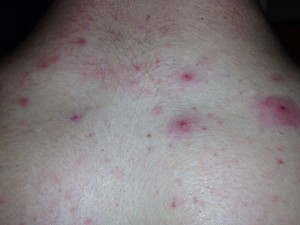Introduction
Necrotising fasciitis is a rare but serious bacterial infection that affects the tissue beneath the skin, and surrounding muscles and organs (fascia).
It’s sometimes called the “flesh-eating disease”, although the bacteria that cause it don’t “eat” flesh – they release toxins that damage nearby tissue.
Necrotising fasciitis can start from a relatively minor injury, such as a small cut, but gets worse very quickly and can be life-threatening if it’s not recognised and treated early on.
Symptoms of necrotising fasciitis
The symptoms of necrotising fasciitis develop quickly over hours or days. They may not be obvious at first and can be similar to less serious conditions such as flu, gastroenteritis or cellulitis.
Early symptoms can include:
a small but painful cut or scratch on the skin
intense pain that’s out of proportion to any damage to the skin
a high temperature (fever) and other flu-like symptoms
After a few hours to days, you may develop:
swelling and redness in the painful area – the swelling will usually feel firm to the touch
dark blotches on the skin that turn into fluid-filled blisters
If left untreated, the infection can spread through the body quickly and cause symptoms such as dizziness, weakness and confusion.
When to get medical help
Necrotising fasciitis is a medical emergency that requires immediate treatment.
[wp_ad_camp_32
Go to your nearest accident and emergency (A&E) department as soon as possible if you think you have it. Call 999 for an ambulance if you’re too unwell to get yourself to A&E.
Blood tests and scans may be carried out to find out what’s causing your symptoms, although a diagnosis of necrotising fasciitis can usually only be confirmed by having an operation to examine the affected tissue.
Treatments for necrotising fasciitis
Necrotising fasciitis needs to be treated in hospital.
The main treatments are:
surgery to remove infected tissue – this may be repeated several times to ensure all the infected tissue is removed, and occasionally it may be necessary to amputate affected limbs
antibiotics – usually several different types are given directly into a vein
supportive treatment – including treatment to control your blood pressure, fluid levels and organ functions
People with the condition will often need to be looked after in an intensive care unit and may need to stay in hospital for several weeks.
While in hospital, they may be isolated from other patients to reduce the risk of spreading the infection.
Outlook for necrotising fasciitis
Necrotising fasciitis can progress very quickly and lead to serious problems such as blood poisoning (sepsis) and organ failure.
Even with treatment, it’s estimated that one or two in every five cases are fatal.
People who survive the infection are sometimes left with long-term disability due to amputation or the removal of a lot of infected tissue.
They may need further surgery to improve the appearance of the affected area and may need ongoing rehabilitation support to help them adapt to their disability.
Causes of necrotising fasciitis
Necrotising fasciitis can be caused by several different types of bacteria.
The bacteria that cause the infection live in the gut, in the throat, or on the skin of some people, where they don’t usually cause any serious problems.
However, in rare cases, they can cause necrotising fasciitis if they get into deep tissue – either through the bloodstream, or an injury or wound, such as:
cuts and scratches
puncture wounds caused by injecting drugs
surgical wounds
Necrotising fasciitis typically occurs when bacteria already on the skin or in the body get into deep tissue. The infection can also be spread from person to person, but this is very rare.
Anyone can get necrotising fasciitis – including young and otherwise healthy people – but it tends to affect older people and those in poor general health.
Preventing necrotising fasciitis
There’s no vaccine for necrotising fasciitis and it’s not always possible to prevent it.
The following measures may help to reduce your risk:
Treat wounds quickly – after stopping any bleeding, clean wounds with running water and pat them dry with a clean towel.
Keep wounds clean and dry – after a wound has been cleaned, cover it with a sterile dressing (such as a plaster); change the dressing if it gets wet or dirty.
Wash your hands regularly with soap and warm water – alcohol-based hand gels can also help, but washing with soap and water is generally best.
If you’re in close contact with someone who has necrotising fasciitis, you may be given a course of antibiotics to reduce your risk of infection.

